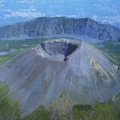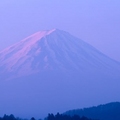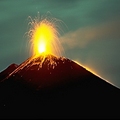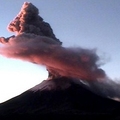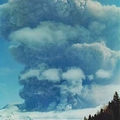Eco-friendly locations / The Best Volcanoes to Visit in the World / Pelee
Pelee
Can we call a miracle a phenomenon that has brought death to thousands of people? Probably not always when you think about it. Terrible is very often intertwined with beautiful and this is a remarkably fact. Another nominee from North America , which passed into the second round, became a volcano of Mont Pelee , the tragic events that unfolded at the dawn of the 20th century. Pelee was named a miracle and at the same time a monster.
Description
Pelee Mountain (fr. Montagne Pelée – the Bald Mountain), or the Mon-Pele is a volcano, located in the northern part of the island of Martinique (Lesser Antilles). Its height is of 1397 m, the base diameter of 15 km. The crater is oval in shape, having a size of 1000 by 750. Notorious, it received from the eruption of 1902, when a cloud of scorching ash and gas (pyroclastic flow) destroyed the city of St. Pierre , killing nearly 30,000 people. In 1929-1932 years the volcano has been active again, resulting in increasing a new dome. At the foot of it is a museum of volcanism. The awakening of the volcano began in April 1902, and the catastrophe broke out on May 8, at 8 hours and 30 minutes in the morning. The eruption occurred suddenly. Deep cracks at the foot of the volcano broke a huge cloud of curly gray color, consisting of pulverized lava , gases and vapors. In all areas of its furrowed lightning, it was rising up and rushing with a roar on the hill town of Saint-Pierre, located 8 km from the volcano. The hurricane of stones and ash blew in a few minutes before the foundation of a flourishing city and destroyed 17 ships in the harbor, standing at the pier. Only the steamer " the Maternity" barely managed to escape with broken masts, littered as snow, ash and steaming in many places. The entire population (about 28 thousand people) and the animals were euthanized with red-hot gases , trees had been torn up by the hurricane and burned. Of the inhabitants of the city survived only two people - the city jail inmate, who was in an underground solitary confinement, and another man. The force of the hurricane was so great, that stood in the square monument, weighing several tons thrown several meters away. The degree of the heating of the gas can be judged by the finds at the crash site wine bottles with necks bent from the heat. The area adjacent to the volcano was covered with a radius of 2 km mass of stones, reaching 7-8 cubic meters. Outpourings of lava during an eruption have not occurred, but later a huge lava tube in the form of a pointed rock - "needle" or "obelisk" - 375 feet high with a diameter of up to 100 meters) got out of the vent of the volcano. A year later, it gradually collapsed, and the volcano has a former appearance. Investigation of the sea floor near the island of Martinique have shown that it sank a few hundred meters. Wonder of the world? Yes, despite the salty taste of tears and blood. Such is the nature :beautiful and cruel.
Others from The Best Volcanoes to Visit in the World
A volcano is formed by a non-visible internal structure of the crust including magma chamber , magma pipes and a visible structure.
More commonly, the term volcano refers only to the outside and the visible part to the right of the volcanic relief , more or less conical, consisting of all those materials, liquid, solid or gaseous fuels, which were issued from the craters during the various stages of the eruption of the volcano itself.
The masses of rocks which form a volcano are called igneous rocks , as derived from the cooling of the magma ascended from the Earth .
The shape and the height of a volcano depend on several factors including the age of the volcano, the type of the eruptive activity, the type of the released magma and the characteristics of the underlying volcanic structure.
In general volcanoes are discontinuities in the Earth's crust through which all various events and magmatic endogenous products: powders, gases, vapors and solid volcanic material is casted.
The release of this material is erupting and the erupted materials are lava , ash , gas , slag and various water vapors .
On the surface, 90% are submarine volcanoes (mostly located along the dorsal mid-ocean), while about 1500 volcanoes are now active on land.
Description What is commonly called a volcano, technical terminology is defined in the volcano or volcanic cone , but since the term most used is the volcano.
The volcano is often named in geology .
The volcanoes testify to the existence, in the deep zones of the lithosphere , the molten masses of silicate are called natural magmas .
A generic volcano is formed by: a magma chamber or a magma basin, fed by magma , when it is empty after an eruption.
A volcano may collapse and create a caldera .
The magma chambers are located between 10 and 50 km depth in the lithosphere .
a stack or a duct volcanic main crossing point of the magma from the magma chamber to the surface.
a crater summit, where the main pipe flows.
one or more secondary ducts, which, flowing from the flanks of the volcano or the same basis, give life to the secondary cones.
lateral cracks, fractures on the longitudinal side of the volcano, caused by the pressure of the magma.
They allow the escape of lava in the form of eruption.
For their grandeur of the event the volcanoes are an object of admiration, of fear, of curiosity and of study since the antiquity with different interpretations created to explain its origin.
Plato admitted the existence of an underground river of fire.
Seneca indicated as the cause of eruptions and earthquakes, the penetration of water into the ground, when the water reached the incandescent matter, vapors under high pressure.
In 79 AD ,Pliny the Younger described the eruption of Vesuvius that buried Pompeii , Herculaneum and Stabiae.
But the real science that studies volcanoes, the volcanology ,was born only in the seventeenth century , when the naturalists were interested in the eruptions of Vesuvius ( in 1631 ) and of Etna ( in 1669 ).
This science is more decisive in progress with the studies of Spallanzani and then in the nineteenth century , with the help of petrography .
The origin of volcanoes is explained by various theories, including two important, but opposite theories: the theory of craters of lifting De Buch ; the theory of external accumulation of Scrope and Spallanzani .
In the theory of De Buch, volcanoes would have originated from the magma which would raise the outer layers of the Earth forming the cone, which then would break up to form the craters.
In the second theory, the volcanoes would be due to the accumulation of the solid material emitted or projected from the volcanic conduit.
The heat that is produced inside exerts a pressure evenly over the crust, thinner where the magma would surrender, letting it , causing the birth of the volcanoes.
The classification of volcanoes The volcanoes can be classified according to the type of external device or the type of the volcanic eruptions, both of these characteristics being closely linked to the composition of the magma and the magma chamber (and thus emitting lava).
This classification is called Lacroix Classification by the French geologist Alfred Lacroix who first conceived.
Depending on the type of the volcanic external apparatus Considering the type of the volcanic cone there are 2 types of volcanoes: 1.
Shield volcanoes 2.
Cone volcanoes Shield volcanoes A shield volcano has moderately sloping sides, and it is built by the eruption of the lava basalt fluid.
The basaltic lava tends to build enormous cones low slope, because its low viscosity allows it to slide smoothly on the ground or under it, in the lava tubes, up to many kilometers without significant cooling.
The major volcanoes of the world are the shield volcanoes.
The name comes from the same geometry, which makes them look like shields resting on the ground.
The largest shield volcano in the world is in Hawaii , its name is Mauna Loa .
It measures about 4000 m above the sea level , but its base is located at 5000 feet below the sea level, so its actual height is of 9000 meters, while its base diameter is about 250 km.
Cone volcanoes We find a volcano cone when the lava is acidic.
In these cases, the magma is very viscous and it is difficult to trace, solidifying quickly once outside.
Emissions flow and alternate with the solid material that is shot out and alternate with the cast, as the layers of the building.
The eruptions of this type can be very violent (like that of Vesuvius that buried Pompeii ), because the magma tends to obstruct the volcanic chimney creating a "cap" only when the internal pressures are sufficient to overcome the obstruction, the eruption resumed ( the eruption of Vulcan type), but in extreme cases there may be an explosion that may come to destroy the entire volcano ( Peleus).
The volcanism of this type is present along the continental margin of the pits or arc-trench systems, where the magma comes from the crust where the rocks are more of an exogenous composition.
Depending on the type of the eruptive activity Broadly speaking we distinguish red volcanoes (volcanoes characterized by effusive emissions in which the accumulation of the volcanic lava flows gives the building looks "reddish brown"), and gray volcanic (eruptions of volcanoes with explosive character in which the accumulation of ash give the building looks gray-black volcanic).
Specifically, considering the type and the power of the eruption of a volcano you have: 1.
Hawaiian volcanoes in eruption type 2.
Volcanoes in eruption of Icelandic type 3.
Strombolian volcanoes in eruption type 4.
Volcano eruption at Vulcan type 5.
Volcano eruption at Vesuvius type 6.
Plinian eruptions at volcanoes and Pelean type 7.
Large calderas ("super-volcanoes") Hawaiian Type The eruptions are not related to the tectonic movements that are due to the plaque but rather to see the phenomena the magma plumes from the back to warm up the hot spots.
The summit of the volcano is occupied by a large depression called caldera , bounded by steep walls due to the collapse of the fund.
Others occur within the caldera collapses, creating a well structure .
The lava is very basic and therefore very fluid, it produces the typical volcanic edifices form a "shield , with weak slopes of the mountains.
Icelandic type They are also called volcanic fissure eruptions which occur through long slits and not by a circular crater.
The casting, basic and the ultra basic magmas fed by, tend to form the highland basalt (basalt plateaus).
At the end of an eruption fissure (or linear), the eruptive fissure may disappear since it is covered by lava and solidified spill, does not reappear until the next eruption.
The best examples are found in Iceland , from which the special designation of the type, an excellent example of the Icelandic volcano eruption is that of Laki of 1783 , one of the most famous volcanic eruptions in the history of the European Union .
Strombolian type Very viscous basaltic magmas give rise to an enduring characterized by emissions at regular intervals and fragments of lava fountains that reach hundreds of meters high, and the launch of lava and volcanic bombs.
The fallout of these products creates scoria cones from the quite steepides .
Stromboli , the island-volcano from which it takes its name, this kind of effusive activity, has been in business for two millennia, much to be known, since the time of the earliest civilizations as the " lighthouse of the Mediterranean .
" Type Vulcan They were named after the island of Vulcano in the archipelago of the Aeolian Islands .
They are explosive eruptions during which lava bombs release clouds of gas and ash laden.
The explosions can produce fractures, ruptures of the crater and the opening of lateral vents.
Vesuvius type From the name of the volcano Vesuvius , it is similar to the Vulcan, but with the difference that the initial explosion is tremendously violent enough to drain most of the magma chamber: the magma from deep zones, then back up at high speed out of the crater and dissolve in tiny droplets.
When this type of eruption is at its most violent it is called Plinian eruption (in honor of Pliny the Younger who first described the course in 79 AD).
Plinian type The eruptions are produced by very viscous magma .
Hot clouds are frequently formed from gas and pulverized lava.
They are very dangerous eruptions ending usually with partial or total collapse of the volcano or the release of a plug of lava that of a volcanic plug or dome .
In some cases both phenomena occur.
The volcanic eruption that exhibits this behavior are characterized by the shape of a cone.
These eruptions are named for Pliny the Younger who first described this type of eruption observing the eruption of Vesuvius in 79 AD, which submerged Pompeii and Herculaneum in ashes .
A variant is the Plinian eruption : if during a Plinian eruption the main body of the glowing cloud released from the crater summit during an eruption peleana (which takes its name from the volcano 's Pelee in Martinique ) , the volcano erupts from the crater, but not centrally splitting up the side of the volcano.
This eruption has devastating effects concentrated in the direction of the main eruption of a glowing cloud that can reach more than 20 km from the building volcanic (as happened in 1980 in the eruption of St.
Helens ).
Other variants of the Plinian eruptions are the ultra-plinian : these eruptions are characterized for having an even bigger explosion, which may come to completely destroy the volcanic edifice (it is an example of the Krakatoa or Santorini ), and above all for the enormous amount of the released volcanic ash.
The explosion of this type, based on the large amount of ash that remains in suspension in the atmosphere, has a greater or lesser impact on the global climate in the years following the eruption.
Large calderas Although not recognized as true volcanoes, they deserve a separate mentioning: the case of 7-8 large calderas identified on the surface.
These structures are characterized by not having a volcano rather than a depression of volcanic origin (known as Caldera), which covers a vast area, more than 10-15 km.
Inside the caldera, you can see the development of various craters formed more or less.
It was never observed an eruption of this type of calderas (which have periods of eruption of hundreds of thousands of years) and these areas are now subject only to a minor type of volcanism (geysers, fumaroles, hot springs, .
.
.
).
The best known examples of this type of equipment is the park of Yellowstone , The Phlegraean Fields , the Alban Hills , the Toba Lake .
Activities of volcanoes The magma rises through the mantle or less dense than the Earth's crust because of the surrounding rocks (lifts for buoyancy ).
During the ascent, due to the decrease in pressure , the gases dissolved in the melt dissolve a further decrease of the density .
The magma in the crust can build up, to cool and solidify, or climb up to the surface of the earth thus giving rise to an eruption .
The eruptions may be of different types: they can give rise to explosive phenomena, where ash and lapilli are projected up to tens of kilometers above the crater and deposited up to hundreds of miles away from the eruptive center, or effusive, if the magma flows, forming a lava flow that propagates to shorter distances (tens of meters to a few km from the eruptive center).
One of the characteristics that influences the type of the eruption is the viscosity of the magma, which depends on the content of silicon , which binds with the oxygen molecules that form always tend to bond with each other and form indestructible chains.
If the magma has more than 60% silica [SiO2] it is considered viscous and more likely to give rise to an explosive eruption, but if the magma has less than 50% silica it is likely to be erupted with dynamic and effusive emitted lava as flows.
Here is a presentation of the most famous and the most popular volcanoes in the world.
Of course, I referred to their power of eruption, their activity and their beautiful environment provided to visitors.
Volcanoes represent huge interest to people, not only for the fact that they are dangerous but for many other reasons too.
Discover the most famous volcanoes in the world.

